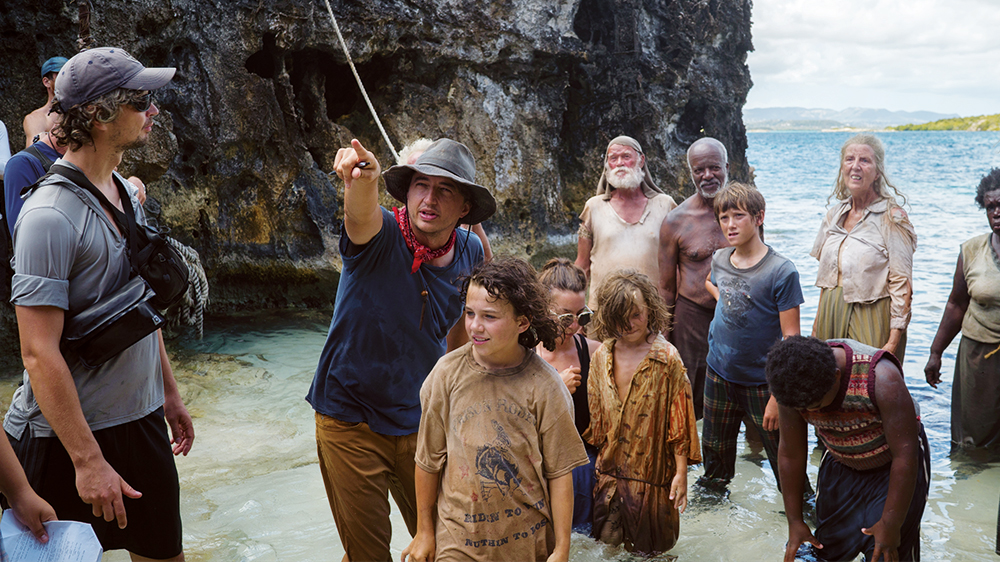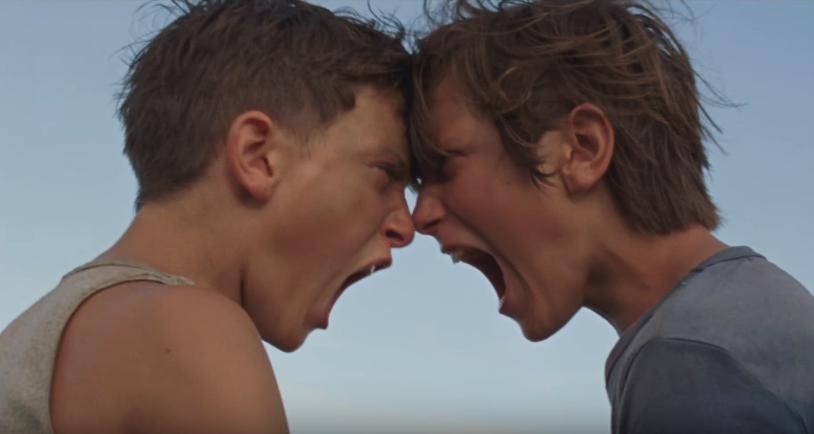Alex writes about Wendy, Benh Zeitlin, and Beasts of the Southern Wild.
Let’s go back to early 2012. A director releases his debut feature, a feature that begins as a widely adored and appreciated Sundance hit. It is released to the general public in the summer of that year, to further acclaim and profits that greatly outweigh what the film cost to make. Listening to people walking out of the cinema I saw it in, all viewers sounded resoundingly positive. In the winter, it would be nominated for four Academy Awards, including Best Picture, Best Actress, and Best Director. It was a type of success anybody would accept. And yet its director didn’t release another feature for eight years. How does this happen?
The picture in question, to those who have yet to figure it out is Beasts of the Southern Wild, a film that I can assure you was beloved at the time of its release but has since been widely forgotten. This is not uncommon: a look at the other nominees for Best Picture that year reveals a collection of films that had their time in the sun, but whom nobody really talks about all that much anymore. This happens at each Academy Awards, or each year in general: there are always myriad successes, but only one or two films each year can really stick in the collective consciousness for longer than an award cycle. In order to do that, your film has to be truly beloved by wide swaths of people.
My recollection of my 2012 review of Beasts of the Southern Wild was something along the lines of: “these special effects are intriguing,” “holy shit does this music bang,” “this sound mix is off the charts,” “that little girl is great,” “does this movie have a plot,” and “are we watching another entry into the world of indie Malick ripoffs?” My companion and I followed the film by going across the street to drink the cheapest beer on the menu and eat salads that were served in bowls made out of fried dough.
“I liked it,” said my friend who has and shall always retain the ability to translate my longer thoughts into shorter, concise ones. “It was a nice story of a father and his daughter.” I could tell from how she said it that she would probably never think about this film again, and I could tell from my reaction to this that I certainly would. I saw Beasts of the Southern Wild two or three more times, because no matter what you say about the film it is an exciting stylistic exercise with a manageable running time, sliding into the slot for “short movie I can see to fill the gaps between two other movie screenings.” I listened to the soundtrack a lot, while writing and while cooking and while walking into screenings of Beasts of the Southern Wild. (Before my second screening was through, I recall thinking, “Is this movie good, or do I just like the music?”) But the day of the Oscars that year was probably the last time I thought of Beasts of the Southern Wild for years.
When Benh Zeitlin finally released a new film earlier this year, Wendy, I was scoffed at for suggesting I was planning on going to see it. Of course, I didn’t end up going, because I planned to see it on a Thursday. But on Wednesday, Rudy Gobert tested positive for COVID-19, and then borders closed, and I had groceries to stock up on. But I thought a lot about why my friend would think it was silly of me to want to see it.
“It’s directed by the guy who made Beasts of the Southern Wild,” I said, “And I kind of feel obligated to see the follow-up.”
For reasons I honestly can’t even put into words, I felt compelled to watch Beasts of the Southern Wild this past Friday night. I needed a guaranteed win, and I knew if nothing else, this short movie with an absolute banger of a score* would get me home. Watching it in 2020, I noticed a few new things that weirdly I have no recollection of hitting me in 2012. Less than ten minutes into the movie, I knew where all the 2012 success came from: this is a Terrence Malick film poured through a Spielbergian strainer, removing all the fat, upping the broad emotions, and telling John Williams to make the audience bawl. It’s a short (all later period Malick movies are too long, I’m told) movie about a kid (as opposed to adult children played by movie stars) and her father (as opposed to lover), there are countless gratuitous handheld shots of nature (this was left unchanged), and the music is overpoweringly emotional.
*I truly cannot make this point loudly enough. I think if this movie had a less exceptional collection of music running underneath it, the collective reaction would have been entirely different.
Zietlin is not the first person to take Malick’s ideas and translate them to a wider audience, of course. These things are rampant; Malick kind of rewrote Hollywood film language, and people took little bits of it and injected it into their own work. David Gordon Green is the Sundance copycat, with his George Washington being a bonafide Terrence Malick covers album. You can see it in Michael Bay’s work, especially the later films, and you can see it in literally every indie movie set outside of a metropolis (and most within as well). Christopher Nolan remains the king of the Malick thieves, filling his movies with brief handheld cutaway shots to signify a different time or a different memory. Malick will be remembered as the Velvet Underground of filmmakers, the man whose work was widely ignored by everybody but filmmakers, and ridiculously influential to those who picked up a camera with a compulsion to tell a story.
Beasts of the Southern Wild has a lot of conflicting ideas in it, and I felt the return of a lot of my own conflicting ideas from 2012. I still feel like this film might be at least vaguely racist, although I couldn’t put the why into words in 2012, but it mostly revolves around a white filmmaker making a film about predominantly black characters. Although, of course, Zeitlin and his team encouraged those actors to have a lot of agency over their characters in the production. When the film was released, there was much talk of Zeitlin’s Court 13 production collective and their collaborative approach to filmmaking, a collaboration that reached all aspects of production.
“There’s so many facets that you can really bring everyone you know together, who you care about, who’s talented, who has a good heart, and they can find their way into creating something good for the movie, provided you allow the individuals working on the film to have agency and to be able to express themselves, which I think is the hardest thing about when you go to work on a traditional set,” Zeitlin told Scott Foundas in filmcomment in 2012. “The creative hierarchy is incredibly regimented and the people actually touching the stuff that ends up on screen don’t have any love for the things they’re making. Even if the designer does, by the time it gets to the person actually painting that or sewing it together, there’s no feeling in that actual task.”
Zeitlin’s approach was to listen to everybody, writing and rewriting dialogue to fit actors after improvisation sessions, and to listen to any idea that might come up during production. (Again, not all that dissimilar from Malick’s style of filmmaking, or Cassavettes, another Zeitlin touchstone.) This feeling of freewheeling creativity permeates the film, and Zeitlin’s job with his post-production team was to (arguably) tie all the exploration together.
I thought a variety of things during my recent screening of Beasts, but I mostly thought: say what you will about this film, but I’m excited to see what this guy can do next. And he had proven he could do a lot with a little. For whatever reason, filmmaking economics don’t always allow for somebody who can do a lot with a little, even when “a lot” translates into four Academy Award nominations. It was viewed as a lark, it seems.
Let’s move back to earlier in 2020. Zeitlin’s new film, Wendy, has its debut at Sundance to little to no fanfare. Despite how closely (I think) I follow American cinema, I did not know the film existed until the day before it was released in a nearby theatre, and the pandemic has done nothing to increase the film’s reach. I would have seen it in theatres but then, of course, you know.
Watching Wendy is a different experience than Beasts of the Southern Wild, if only because the Zeitlin style of freewheeling indie bombast is no longer new to those of us who saw his debut. The styles of each film are the same, with loud music and unconnected voiceovers paired with footage of children running around and generally being adventurous. As all reviews and/or pieces about the film must claim, Wendy is a reimagining of the story of Peter Pan for the Sundance set, which is just about the most “Spielberg by way of Malick” thing you could possibly imagine.
There are moments where Wendy is as impactful as Beasts of the Southern Wild, just as there are moments in Wendy that are bland and stale (not unlike Beasts of the Southern Wild). The main difference is that, with Wendy gallivanting for approximately twenty minutes longer, the gaps between the good and bad moments are larger, making an already disconnected style feel even more disconnected. With a movie that runs 93 minutes, like Beasts, you power through the two slower minutes before Dan Romer joins in to blow out your eardrums, but with Wendy you often have to stick with what is a less engaging scene for an extra couple of minutes. This is not an argument to make all films shorter, more that the runtime of Wendy simply allows the viewer to meditate on its missteps more, in between the moments of triumphant adventure. And there are some truly beautiful moments in Wendy. From the introduction to Wendy herself and the film’s title card*, to the out of nowhere emotional wallop that comes in the montage after Wendy and her brother return home to live their own adventures, the film never goes too long in between instances of jogging your memory to remind you of Beasts’ finer moments.
*Which, it should be noted, is incredibly similar to the opening of Beasts.
The highlight of the film is the way Wendy depicts twin brothers Douglas and James adapting to life after Douglas is believed dead. After running off to the island where the majority of the film takes place, a place where a volcano named Mother stops its inhabitants from aging, Wendy and her brothers go swimming amidst the wreckage of a sunken boat. Douglas hits his head, starts bleeding, and appears to be lost underwater. As time passes without his brother, James watches his own right arm grow old, eventually demanding Peter cut it off. James becomes old, bitter, and lost, crossing the barrier to the less populated part of the island, where those who feel cast off by the island society go to wander meaninglessly. When Douglas returns late in the film as a still-young boy*, James and Douglas are able to look at themselves older and younger simultaneously. They are able to see what the world has done to James, and what it has yet to do to Douglas.
*Out of nowhere, and with seemingly no explanation, but plenty of things in this movie are totally unexplained.
Now, writing this all out makes the movie sound deeply terrible. And it might be. The highs are very high, but they are spaced out, and there are many more lows. But the moments where Wendy hits its peak are glorious, and this is one of those moments. The film wordlessly shows us the twins, one old and one young, in a graphic match to a shot from when they first arrived on the island. Instead of the whole world being in front of them to play with and explore, however, now James has been overcome by the darker elements of it. He experienced a life without what he needed to be happy, and he can see a younger version of himself with that whole life left in front of him, the younger version looking back at him, silently hoping to avoid the same mistakes. Because this is still technically a Peter Pan story, James has fashioned himself a hook to replace his hand, gathering his fellow Olds to fight back against the island and Mother.
The film sprints to its end, with Wendy and Douglas rushing home to their mother, and a montage of their lives from there on out begins. Wendy has her own child, who is eventually taken away by Peter on a train in the middle of the night, a train Wendy rushes to chase after but can’t keep up with. She knows her own daughter needs this, and so she lets it happen. (It is weird to see a film end with a mother being okay with her child being kidnapped, but this is how Zeitlin’s world works, I guess.)
Again, watching this film and thinking about it and (especially) typing it out all make Wendy sound like nonsense. And, as I keep saying, it might be. But one truth of it is that I love how this nonsense feels, even when I am occasionally a little bored with it. Wendy plays like a movie steeped in a type of freedom filmmakers would pine for, and it is able to feel as free as it does specifically because Zeitlin doesn’t need the Hollywood infrastructure to make the films he wants to make. By keeping his work strictly independent, he is able to do what he wants (at least for now). Wendy’s lack of success might make his next adventure slightly more difficult to fund, but he found a way to make Beasts of the Southern Wild happen, so I have no doubt he’ll be able to do the same again.
The lack of cohesive structure in Zeitlin’s films creates a high risk, high reward sort of proposition for the viewer. Either this montage will work and the viewer will be exhilarated, or this montage won’t work and probably none of them will and oh no now that guy’s snoring in the fifth row. I have experienced this a lot of times; I keep referencing Terrence Malick’s movies in this essay and others because I am one of his bigger fans. I have seen people nod off during montages I would describe as “perfection,” and I always understand why they do. This movie may be terrible, but – while I may lack the words to properly explain why – it is most certainly for me.
Something that has bothered me (and surely always will) is the impossibility to describe what about a song is so exciting to me. Much of my favourite music is instrumental, and even an appreciation of something like Run the Jewels requires me feebly explaining ethereal concepts that convey some sort of feeling. Similarly, Zeitlin’s two films are so strongly tied to their scores (composed by Zietlin and Dan Romer). Wendy and especially Beasts often feel more like songs than movies, with ideas tossed to the audience and then discarded, because the mechanics don’t matter so much as the feeling they convey. The specifics are meaningless, because nobody is going to remember the exact lyrics anyway. All that matters is how it feels.
Before leaving the island, Wendy joins her fellow inhabitants, both young and old, in singing a chant to Mother. They are all singing in unison, in hopes that what they call out will be picked up and a volcano will erupt (or whatever the actual plot is). It doesn’t matter if anybody can hear them though; hearing the call never mattered. All that mattered was still being able to sing, in the hopes that somebody will hear it. But either way, calling out means something to its singer.
Both of these films might be bad, or both of them might be good. There’s simply not much of a difference between them beyond the runtime. The pervasive feeling I have, that publishing this will put a button on my desire to watch either of them again, leads me to believe they’re closer to bad than good. But I enjoyed watching them; Beasts was an interesting experience in 2012, and Wendy was a different kind of interesting experience in 2020.
There are always going to be people who create something that seems new and exciting, and occasionally that new and exciting thing might actually be an old thing repackaged in a new, exciting style. That, along with an ad campaign that works, will lead a portion of the masses to your film. You will bask in your success for as long as it lasts, always concerned it might disappear in the blink of an eye.
Those same creative people might then need a little bit of time to create the next new and exciting thing. By then, of course, the world might have changed, because the world is always changing (and seems to be doing so at a much more rapid pace than was done in 2012). The singular truth that will remain, however, is that the gatekeepers of Hollywood will follow the money, and if the new idea doesn’t seem like something that will make money (and the previous person who gave you money is either bankrupt or no longer wants to give you money), then you’re screwed. You are left to your own devices, to create a world people may or may not want to be a part of. It doesn’t matter. It was never meant for them, anyway.






